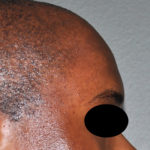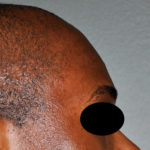Reshaping the forehead is an uncommon patient request. While the plastic surgery techniques to do so are well known and not new, the need to do forehead contouring is not. Most commonly, forehead reshaping is done on patients who had a congenital skull deformity (e.g., craniosynostosis) or a frontal skull deformity secondary to trauma or after a neurosurgery craniotomy procedure. The cosmetic reasons would be to soften prominent brow ridges or to smooth out some forehead irregularities.
The treatment of forehead irregularities can theoretically be done by either burring down bone or adding a synthetic material to it. In reality, burring down bone on the skull is a limited procedure and can never make as big a difference as one would think. The brow ridges can be burred down but the limiting factor is the underlying frontal sinus. If the overlying frontal sinus bone is thin, then very little bone can actually be taken. Above the brow ridges, burring down forehead bone is very effective for small raised areas that are easily identifiable but is less effective at reducing large surface areas of bone.

Regardless of the material used, synthetic forehead augmentation usually requires an open scalp incision which, because of its length, is a significant consideration in a cosmetic procedure. (particularly for men) Endoscopic or limited scalp incisions may be able to be used in small areas of augmentation in carefully selected cases.
Dr. Barry Eppley
Indianapolis, Indiana



